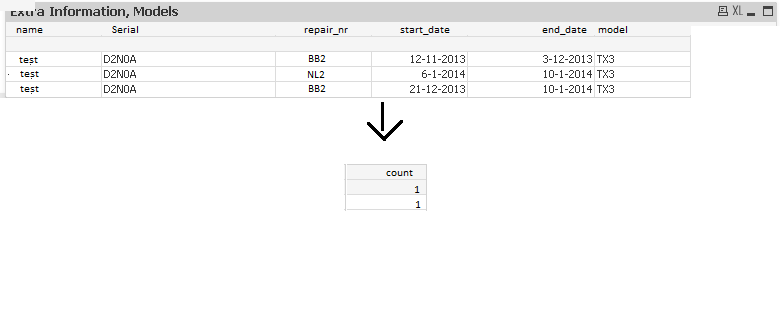Unlock a world of possibilities! Login now and discover the exclusive benefits awaiting you.
- Qlik Community
- :
- All Forums
- :
- QlikView App Dev
- :
- Re: how to get count of duplicate values under 90 ...
- Subscribe to RSS Feed
- Mark Topic as New
- Mark Topic as Read
- Float this Topic for Current User
- Bookmark
- Subscribe
- Mute
- Printer Friendly Page
- Mark as New
- Bookmark
- Subscribe
- Mute
- Subscribe to RSS Feed
- Permalink
- Report Inappropriate Content
how to get count of duplicate values under 90 days
Hi,
In excel i have the following table:
| case_id | repair_nr | issue_date | end_date |
|---|---|---|---|
| 1A | 1 | 1-1-2014 | 3-2-2014 |
| 2A | 2 | 2-2-2014 | 3-2-2014 |
| 3A | 3 | 3-2-2014 | 3-2-2014 |
| 1A | 4 | 20-2-2014 | 1-3-2014 |
| 1A | 5 | 1-11-2014 | 10-11-2014 |
For every same case_id i want to check if the end_date from one case_id and the issue_date from another case id falls under 90 days, if yes then there must come a column for count where this count will be +1, for example:
In this table there are three same case_ids => 1A. In qlikview i first need to check if there are matching case_ids in a table, if so then to check if the end_date from for example 1A with repair nr 1 and the issue_date from 1A with repair_nr 4 and repair_nr 5 etc is under 90 days. also if end date from 1A with repair_nr 4 and issue date from 1A with repair nr 5 is also below 90 days etc.
So for example here there are 2 matching 1A case ids that are under 90 days so count will be 1 for these.
So if case_id is the same then check end date from that case with all other issue date if it falls under 90 days if yes then get a count table and count the case_ids..
so for example(see serial as case_id) and for example every repair_nr with other letters other than starting with BB must be removed from the list so outcome with count will be like this:

Can anyone help me out how this will be possible?
- Tags:
- qlikview_scripting
- « Previous Replies
-
- 1
- 2
- Next Replies »
- Mark as New
- Bookmark
- Subscribe
- Mute
- Subscribe to RSS Feed
- Permalink
- Report Inappropriate Content
Do in need to insert this as an expression or at script side? and what if issue date and end date come are in another table although the table are connected to each other?
- Mark as New
- Bookmark
- Subscribe
- Mute
- Subscribe to RSS Feed
- Permalink
- Report Inappropriate Content
Use as an expression. It doesn't matter if the fields are in different tables, as long as they are associated.
Rob
- Mark as New
- Bookmark
- Subscribe
- Mute
- Subscribe to RSS Feed
- Permalink
- Report Inappropriate Content
Does not work. But if you use a distinct how will it be possible to check count the double case_id
for example case_id = 1A + repair_nr = 1 and case_id = 1A + repair_nr 2 + case_id 1A + repair_no=3 must give a count of 2(not 1 nor 3)
- Mark as New
- Bookmark
- Subscribe
- Mute
- Subscribe to RSS Feed
- Permalink
- Report Inappropriate Content
You can add in the repair_nr if you want to consider that also:
=count({<case_id={"=end_date-issue_date < 90"}>}DISTINCT case_id & repair_nr)
But that's different than your original question.
"So for example here there are 2 matching 1A case ids that are under 90 days so count will be 1 for these."
-Rob
- Mark as New
- Bookmark
- Subscribe
- Mute
- Subscribe to RSS Feed
- Permalink
- Report Inappropriate Content
Dear Rob,
I will try to explain more clearly.
Imagine i have this table
Case_id: repair_nr issue_date end_date
1A BG1234 1-2-2014 2-2-2014
1A BG2234 5-2-2014 12-2-2014
1A RO3234 10-2-2014 12-2-2014
repair_nr will always be unique. Imagine case_id=1A will be brought for repair 2 times. 1 time on 1-2-2014 and 1 time on 5-2-2014, on 10-2-2014 the repair with BG2234 moved to another repair center.
So in this scenario for all same case_ids we want to calculate the second time returns. So it must be 1 time and not 2.
Because the RO3234 is not a second time return but its just a tranfser from bg to ro.
Will this be possible?
- Mark as New
- Bookmark
- Subscribe
- Mute
- Subscribe to RSS Feed
- Permalink
- Report Inappropriate Content
So having the same end_date makes it the same repair? In that case include end_date
=count({<case_id={"=end_date-issue_date < 90"}>}DISTINCT case_id & end_date)
It gets a little more complicated if duration for both repairs should be considered as 12-2-2014 minus 502-2014.
-Rob
- Mark as New
- Bookmark
- Subscribe
- Mute
- Subscribe to RSS Feed
- Permalink
- Report Inappropriate Content
No, a repair can for example be transeffered to another repair center and then it will get another repair_nr for example then it will start with RO,
So every case with repair nr RO needs to be deducted..
- Mark as New
- Bookmark
- Subscribe
- Mute
- Subscribe to RSS Feed
- Permalink
- Report Inappropriate Content
=count({<case_id={"=end_date-issue_date < 90"}>}DISTINCT case_id & end_date)
This doesnt work it doesnt give any results... i have qlikview 10
- « Previous Replies
-
- 1
- 2
- Next Replies »